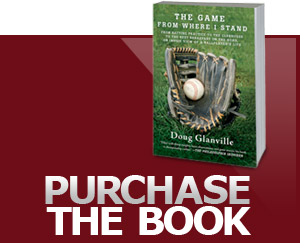The Call Up
The New York Times
September 8, 2008
by Doug Glanville
This is an exciting time of year for a special group of minor league baseball players. Every Sept. 1, major league teams can expand their rosters from 25 to 40 players, and because of that expansion a select few will get their first taste of the big leagues.
My major league debut came earlier in the season, on June 9, 1996, on a freezing cold and rainy day in Wrigley Field. After years toiling away in the minor leagues on a dream and a prayer, I had finally made it.
But had I truly arrived?
“Arriving” implies longevity and a deep-rooted understanding that you belong somewhere, that you’re not just passing through. And the amazing thing about arriving in the big leagues is that it only starts to feel valid when you get a stamp of approval from your childhood.
Give me a minute to explain.
I was playing with the Chicago Cubs’ minor league Triple-A affiliate in Des Moines, Iowa. I knew something was up when I started one game in left field, a position I had never played in my entire professional career. But when it comes to helping the major league team, you have to be ready to play anywhere just to get in the door. Although I was a centerfielder by nature, if the Chicago Cubs needed a leftfielder, then I was a leftfielder.
After the game, I got called into the manager’s office. This was always bad news for me — that year because this particular manager was more likely to run me over in the parking lot after a game than shake my hand. But once I saw two of my teammates, Mike Hubbard and Terry Shumpert, in the office, I sensed that the big “call up” was about to happen. After five years of minor league baseball, I was a moment away from going to “The Show.”
“Congratulations, you earned it,” our manager said to Mike. He told Terry, “You’ve been there before, you know what to do.” Then he turned to me: “If you make the same mistakes up there as you did down here, you will be back here.”
He wasn’t my biggest fan.
Nevertheless, he couldn’t stop me from getting on that plane to Chicago. I spent all night packing and calling friends and family. I went from my West Des Moines apartment to the airport to catch a 7:00 a.m. flight on two hours’ sleep.
After arriving at Wrigley Field, I picked up my jaw from seeing my name in the lineup — as the starting leftfielder — mixed in with the Cub greats Ryne Sandberg and Sammy Sosa. I proceeded to have an uneventful first game, statistically. No hits, a nice diving catch and a near heart attack from excitement. But I had made it.
Even so, it still felt surreal. My manager in Iowa had been brutal in his send-off, but his words had a ring of truth in terms of the tenuous nature of the big leagues. As I survived another day on a major league roster, I slid further into disbelief: I was still trying to figure out whether it had actually happened. I kept looking at the newspaper wondering, “Who is this new guy Glanville?”
This “Glanville” only truly became me when I was able to match the expectations I had as a young kid in Teaneck, N.J.; the measure for whether I’d arrived was based on a childhood barometer. Basically, it meant that I had to have enough major league service to be included in a Strat-O-Matic baseball set (a dice-rolling card game that I played religiously); to see my name written in script on the side of a Rawlings baseball glove; and to gain sufficient influence to meet my favorite band, Hall and Oates.
To my childhood self, a player’s arrival had very little to do with actually getting there. After all, I was playing a kid’s game, and these criteria are fair in a kid’s world.
But I soon understood that the stakes were high. I understood that a million baseball players would always be trying to take my job. Still, in my heart, baseball at its core felt like it did when I’d first connected to it 25 years before. So it made sense that tasting major league action was one thing, but hanging around long enough to have a baseball card was quite another.
Ultimately, I would find my card in that Strat-O-Matic game set, just as I would one day receive two gloves in my locker from a contract with Rawlings, with my name scripted across the side. It was like the good old days, when I would have a catch with my brother using a glove that had the signature of my favorite Phillies pitcher, Steve Carlton, on the side. As far as I was concerned, when I wore that glove, Steve Carlton was tangible.
And that, in effect, is when “Doug Glanville” could finally become real, too. Only then did the childhood version of me nod his head and say, “O.K., now you have made it.”
Republished from The NY Times





